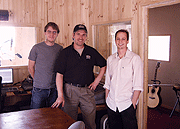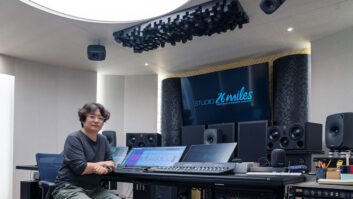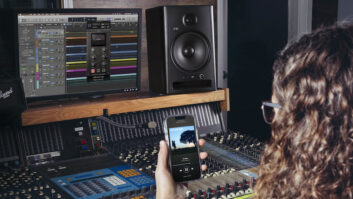
Some of the Studio 116 crew (L-R): Tyler Davis, Phillippe Carillo, Jon Coyne
The owner and engineers at Studio 116 (Hollywood, www.studio116.net) are, first and foremost, audio aficionados. Rather than jumping to bring in the latest digital console, line array or outboard goodie, owner Philippe Carillo and his team (engineer Tyler Davis, Jon Coyne and a slew of on-hand engineers) focus on what matters most during a gig: the sound. “If you have good sound, you help the artist communicate to the audience,” Carillo explains. “The main goal is for the sound engineer to be pretty much ‘invisible’ to achieve this. If the audience sees that there is a problem, they’re going to turn back, and ask, ‘Where is the sound engineer?’ So if there is no problem and the band arrives onstage and everything is going right, it’s an ideal situation.”
This ties in nicely to Carillo’s adherence to the importance of sound, which he believes is the last thing most customers think about as you can’t really see a sound wave. So the folks at Studio 116 maintain a strict adherence to employing top engineers and gear to get the job done right. “You have to be prepared to have the right equipment, have the right people; you have to keep in mind that even if it’s done right, problems can happen,” Carillo explains. “So with the experience you have, you can figure out what can [go wrong at an event] even if you think everything is good. And when you know that, you can avoid the problem by checking everything.”
But that’s happening behind the scenes. For the company’s more lower-end customers, such as weddings, red-carpet events and the like — and even with some of the more complex gigs — a duty to work side-by-side with the client still reigns as Number One on their to-do list. According to Coyne, “We work for the client: We put a lot of time into planning the event ahead of time. We come to an agreement with the client and then we make their event right no matter what it takes.
“When I’m sound-engineering on a job, it’s a selfless position,” Coyne continues. “My Number One is the event and the event is my life at that point. Anything it takes to make the event go correctly is my goal. When you’re on a crew, it’s really selfless in that you’re working as one entity to make the event go correctly.”
It’s this attention to quality sound and detail that has kept the company in high demand in the Hollywood area, but it’s interesting to note that Studio 116 hasn’t upped the ante with their equipment offerings — yet. While the company keeps a stock supply of Allen & Heath, Yamaha and Soundcraft boards, as well as a full EAW system and Crown amps, the move to digital hasn’t really happened. “Digital boards are more suitable for tours and such where you’re actually going to go out and do rehearsals,” Coyne explains. “A lot of the stuff we do is really same-day: We go to the site, set up and we may only have that day to operate the event. When we get into more extended periods of time where we’re going to be working with clients such as a tour or an installation, we may go digital.
“It’s not that we can’t handle a digital necessity if that’s required,” Coyne is quick to point out. “For instance, I just put in a bid for University of Southern California where they require digital boards and I’m going to bid that in because what it comes down to is if that’s what’s needed for the job, we’ll provide that and we’ll find a way to make that work. It’s not something we use all the time because right now it’s not necessary, but we are getting to that level where it will be.”
Always looking toward expanding the business, Studio 116 recently opened a recording studio in the same facility. Carillo, who has experience as a studio engineer, designed the room, which has hosted dates with big-name gospel/R&B artists, including Angie Stone, Warren Campbell and PK Carter.
“We’re family,” Davis adds. “We communicate and have everything flow in one space. We run one of our Soundcraft boards using the pre’s from that and using that to monitor with Delta SR Series. We also use a variety of rackmount preamps: PreSonus, Alesis FireWire A/D, which goes into either Logic or Pro Tools. We’re fully digital, although we do have a 2-track mastering deck.” Monitoring is via Event 20/20s, Blue Skys, Tannoys and ADAM mains.
“What [artists] love about the studio is it’s very different from ‘Hollywood’ studios; it’s in the foothills of L.A. and we have windows in the studio where you can see the sunset,” Davis continues. “We designed it with sound in mind.”
Sarah Benzuly is the group managing editor at Mix, EM and Remix magazines.







